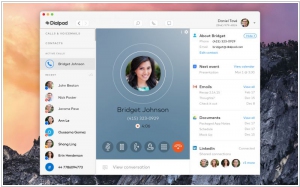Dialpad vs Zoom
March 18, 2025 | Author: Adam Levine
15★
A business phone system that works the way it should. Reign in your remote workforce with a single place for business conversations, no matter the device or location. With mobile apps that make you feel like you’re working out of HQ, your business phone system now goes where you go. Understand why callers are reaching your business (plus what was said) with native Ai insights.
36★
Zoom unifies cloud video conferencing, simple online meetings, and cross platform group chat into one easy-to-use platform. Our solution offers the best video, audio, and screen-sharing experience across Zoom Rooms, Windows, Mac, iOS, Android, and H.323/SIP room systems.
Dialpad and Zoom, at first glance, seem like long-lost twins separated at birth—both offer VoIP calling, video conferencing and messaging, both live in the cloud like particularly smug rain droplets and both claim to integrate seamlessly with your existing business tools (which, let’s be honest, they probably don’t). They have AI features that transcribe what you say, remove background noise and generally attempt to make human conversation slightly less awkward. Naturally, they also work on both desktop and mobile, ensuring that you can be contacted anytime, anywhere, by people you were desperately trying to avoid.
Dialpad, however, insists that it was here first (2011) and unlike its flashy sibling, it is deeply obsessed with AI-driven business telephony, contact centers and making your sales calls sound marginally less disastrous. It has a built-in AI assistant that listens to your calls, presumably judging you silently, while offering real-time coaching to prevent you from saying something regrettable. It thrives in the world of enterprise communications, where phrases like "synergy" and "bandwidth" are spoken unironically and it takes its mission of making phone calls slightly less painful with all the seriousness of a machine that knows it will one day replace you.
Zoom, by contrast, arrived fashionably late in 2013 and promptly became the darling of remote workers, teachers and anyone who suddenly found themselves required to host awkward video meetings. It originally specialized in video conferencing but later decided it wanted to be a phone system too, much like a toaster deciding it also wants to be a fridge. It excels at large-scale webinars and virtual events, which means it’s popular in education, telehealth and any industry where people need to look engaged while secretly doing something else. It also offers breakout rooms, virtual backgrounds and the uncanny ability to turn every minor technical issue into a full-scale existential crisis.
See also: Top 10 Business Phone systems
Dialpad, however, insists that it was here first (2011) and unlike its flashy sibling, it is deeply obsessed with AI-driven business telephony, contact centers and making your sales calls sound marginally less disastrous. It has a built-in AI assistant that listens to your calls, presumably judging you silently, while offering real-time coaching to prevent you from saying something regrettable. It thrives in the world of enterprise communications, where phrases like "synergy" and "bandwidth" are spoken unironically and it takes its mission of making phone calls slightly less painful with all the seriousness of a machine that knows it will one day replace you.
Zoom, by contrast, arrived fashionably late in 2013 and promptly became the darling of remote workers, teachers and anyone who suddenly found themselves required to host awkward video meetings. It originally specialized in video conferencing but later decided it wanted to be a phone system too, much like a toaster deciding it also wants to be a fridge. It excels at large-scale webinars and virtual events, which means it’s popular in education, telehealth and any industry where people need to look engaged while secretly doing something else. It also offers breakout rooms, virtual backgrounds and the uncanny ability to turn every minor technical issue into a full-scale existential crisis.
See also: Top 10 Business Phone systems




